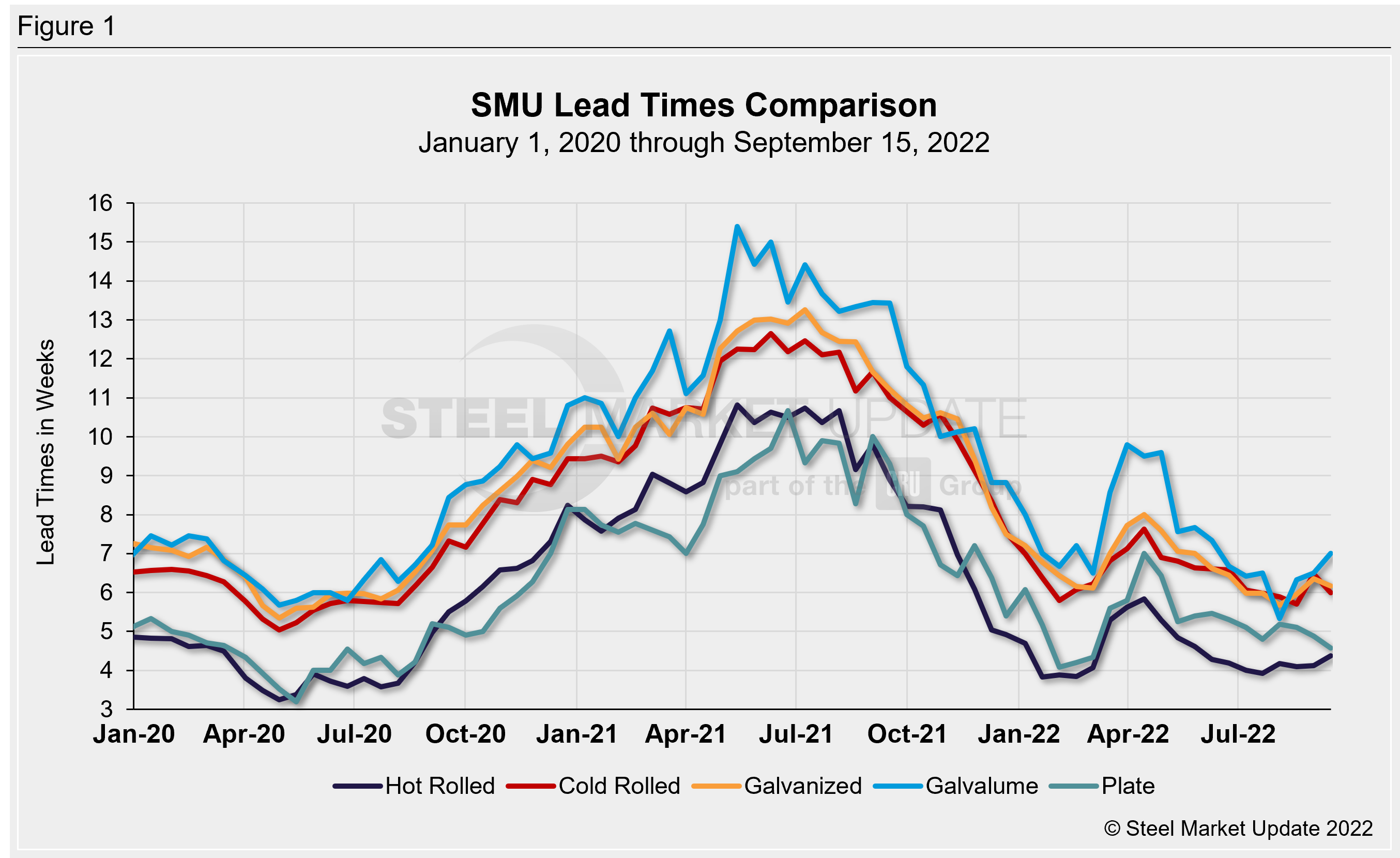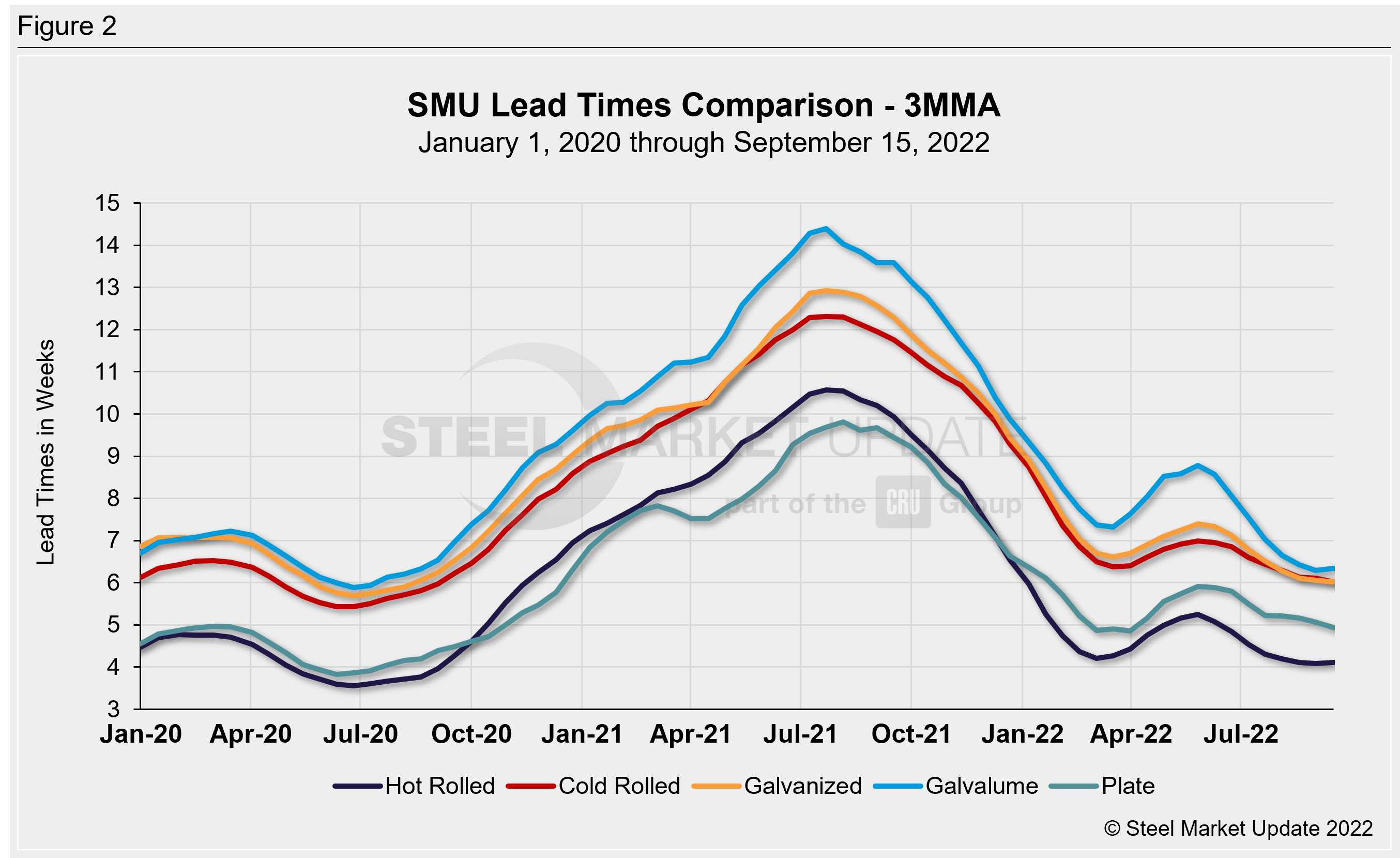SMU Data and Models

Steel Mill Lead Times Hold Steady
Written by Brett Linton
September 15, 2022
Steel mill lead times were overall flat this week, with the processing time for some orders slightly extending and others shrinking. Hot rolled and Galvalume lead times increased compared to our previous market check, while cold rolled, galvanized, and plate lead times slightly declined.
On average this week, lead times were unchanged compared to two weeks prior, and extended 0.2 weeks compared to levels one month ago. Having gradually declined from the April peak, lead times generally remain in line with early 2022 levels.
Buyers surveyed this week reported mill lead times ranging from 4–6 weeks for hot rolled, 5–8 weeks for cold rolled, 5–7 weeks for galvanized, 6–8 weeks for Galvalume, and 4–6 weeks for plate.
SMU’s hot rolled lead times lengthened by 0.3 weeks compared to both two weeks ago and one month prior, now standing at 4.4 weeks. HR lead times have extended by half a week since the recent low in late July. The lowest hot rolled level this year was 3.8 weeks seen in January and in February. The record low in our ~11-year data history was 2.8 weeks in October 2016.
Cold rolled lead times shrunk by 0.5 weeks to 6.0 weeks, the fourth lowest level recorded so far this year. Galvanized lead times also declined, sliding 0.2 weeks to 6.2 weeks (our record low was 4.8 weeks in February 2015). The average Galvalume lead time rose by 0.5 weeks to 7.0 weeks. Note that Galvalume figures can be more volatile due to the limited size of that market and our smaller sample size. One month ago, Galvalume lead times were 6.3 weeks.
Plate lead times eased 0.3 weeks to 4.6 weeks, now at the lowest level seen since early March. The lowest plate lead time this year was 4.1 weeks in early February. In our four-year history of plate lead times, the lowest figure we have recorded was 3.2 weeks in May 2020.
Approximately 74% of the executives responding to this week’s questionnaire told SMU they were seeing stable lead times, unchanged from our previous survey. 18% reported lead times were slipping and 8% said lead times were extending, relatively unchanged from levels two weeks ago. Here is what a few of our respondents had to say:
“Customers are only buying what they absolutely need, mills will not nail down pricing.”
“Lead times are still short, some mills firming up.”
“Things are stable, but they’re so short it is wild.”
“Stable and short.”
“Shorter than normal.”
“Maybe a little movement longer.”

Looking at lead times on a three-month moving average (3MMA) can smooth out the variability in the biweekly readings. As a 3MMA, all products were steady or down compared to two weeks prior. The latest 3MMA lead time for hot rolled held steady at 4.1 weeks, unchanged since mid-August and one of the lowest levels seen since the summer of 2020. Cold rolled and galvanized both moved lower by 0.1 weeks to 6.0 weeks, but were at two-year lows. Galvalume held steady at 6.3 weeks, while plate eased 0.2 weeks to 4.9 weeks (now nearing a six-month low).

Note: These lead times are based on the average from manufacturers and steel service centers who participated in this week’s SMU market trends analysis. SMU measures lead times as the time it takes from when an order is placed with the mill to when the order is processed and ready for shipping, not including delivery time to the buyer. Our lead times do not predict what any individual may get from any specific mill supplier. Look to your mill rep for actual lead times. To see an interactive history of our Steel Mill Lead Times data, visit our website here.
By Brett Linton, Brett@SteelMarketUpdate.com

Brett Linton
Read more from Brett LintonLatest in SMU Data and Models

SMU Survey: Buyers’ Sentiment rebounds from multi-year low
Both of SMU’s Steel Buyers’ Sentiment Indices edged higher this week. Current Sentiment rebounded from a near five-year low, while Future Sentiment rose to a two-month high

SMU flat-rolled market survey results now available
SMU’s latest steel buyers market survey results are now available on our website to all premium members.

SMU Survey: Sheet lead times pull back after early-June blip, plate holds
Following the uptick seen two weeks ago, lead times eased this week for all four sheet products tracked by SMU, while plate lead times held steady, according to this week’s market survey.

SMU Survey: Pricing power abruptly shifts to steel buyers
The majority of steel buyers responding to our latest market survey say domestic mills are more willing to talk price on sheet and plate products than they were earlier this month. Sheet negotiation rates rebounded across the board compared to early June, while our plate negotiation rate hit a full 100%.

Service centers: Mill orders down marginally in May
SMU’s Mill Order Index (MOI) declined for a third straight month in May, but only marginally.
